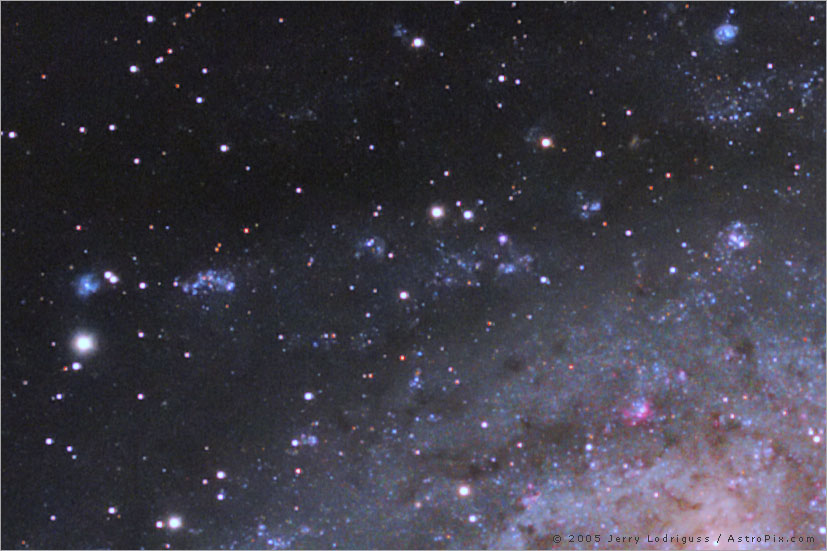
M33, the Pinwheel Galaxy, is a beautiful large face-on spiral galaxy located in the constellation of Triangulum.
Also known as NGC 598, and the Triangulum Galaxy, M33 was first discovered more than 350 years ago by Hodierna, and then re-discovered by comet-hunter Charles Messier in 1764.

Star forming regions, blue reflection nebulae and red emission nebulae inside of M33 can be seen in this 100 percent enlargement of the upper left part of the frame.
Exposure Data
- Lens: Astro-Physics 130EDT f/8 Triplet Apochromatic Refractor
- F/stop: f/6 with 0.75x matched Telecompressor
- Exposure: Composite of 14 frames, 122.5 minutes total exposure:
- 6 frames at 10 min each at ISO 1600
- 2 frames at 5 min each at ISO 800
- 3 frames at 7.5 min each at ISO 1600
- 3 frames at 10 min each at ISO 800
- Mount: Polar-aligned tracking equatorial mount, auto-guided
- Camera: Canon EOS 20Da DSLR
- Mode: RAW
- ISO: 800, 1600
- Filter: None
- White Balance: Daylight
- In-Camera Noise Reduction: Off
- Temp: 50F
- Time 01:40 a.m. EDT
- Date September 3, 2005
- Location: Black Forest Star Party
- Calibration: Each 16-bit linear TIFF file raw light frame was calibrated with a master dark frame before Bayer interpolation.
- Processing: The calibrated light frames were registered in Images Plus, and then normalized, weighted, and averaged together with min-max exclude to create a master 16-bit linear light frame. The sky background was neutralized in levels in Photoshop. A slightly uneven background and some slight amp glow in the lower right corner of the full frame image were then removed with GradientXTerminator. The color was then enhanced by an increase in the saturation of the blue and red color components. An SMI enhancement was applied and faded to 50 percent opacity. A high-pass filter was then applied to a copy of the background layer and it was blended via lighten mode and the opacity adjusted to 50 percent. Finally, Noise Ninja was applied, and the filter faded to 50 percent.
Back |
Up |
Next
|